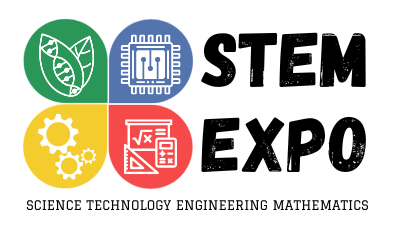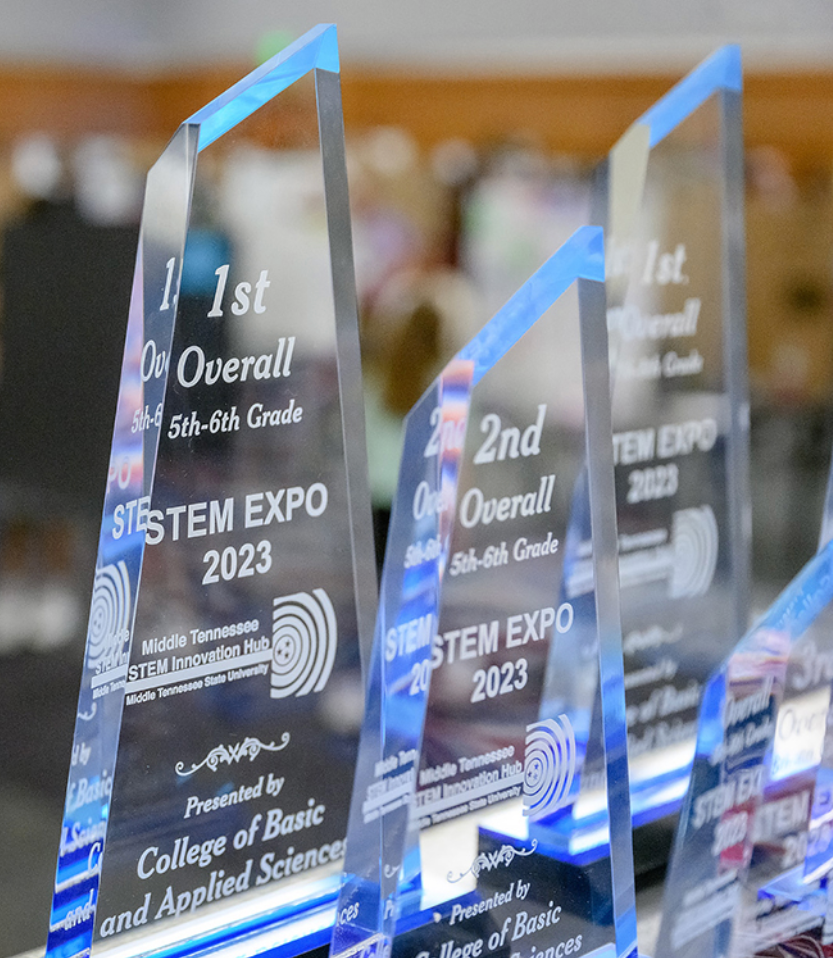2024 STEM EXPO, April 3rd, MTSU Student Union Building
|

The Middle Tennessee STEM Innovation Hub invite 5th-12th grade students in Middle Tennessee to work individually or in teams of up to 5 students
to prepare and present their STEM project at STEM EXPO at MTSU. Students engage in projects involving a process of inquiry in response to a complex
question, problem or challenge. These rigorous projects help students learn key academic content and practice skills necessary for success such
as communication, collaboration, and critical thinking. The STEM EXPO will showcase original projects by middle and high school students
from across middle Tennessee.
|
 |
Important Event Information
Printable Version
Categories
Projects will be entered into one of four categories (outlined below) based on teacher
classification at the time of submission and will be divided into one of three age
groups (5-6th, 7-8th, and 9-12th). Schools may register multiple entries per category and age group.
- STEM Research: Science, Mathematics, Engineering, Biotechnology, or Medicine/Veterinary Medicine
- Engineering: Mechanical, Industrial, Civil, Aerospace, Automotive, Environmental, Biomedical,
Chemical, Electrical or other Engineering fields
- Agricultural STEM: Agricultural production and science
- Technology: Computer programming, programming computer games, designing computer applications,
or designing websites
Judging Criteria & Awards
STEM EXPO is designed as a competitive event between students/teams. At least one participating student must be present at the Expo to represent each
entry. Projects will be evaluated using a common rubric. Please note that the rubric has been modified from the one used in prior years.
Awards will be granted to the top performers in each category and age group.
View RUBRIC
Rules & Safety Guidelines
- Projects may be submitted by an individual student or a team of students (maximum
of 5 students per team).
- Students may only be represented by one project in the STEM EXPO.
- Completed projects must demonstrate that students went through an extended process
of inquiry in response to a complex question, problem, or challenge.
- Each project must be represented at the STEM Exposition by at least one student who
actually participated in the project. Projects with no student representatives will
not be evaluated.
- Each individual or team entering a project will be interviewed by evaluators.
- The evidence component requires students to show proof of project completion, demonstrating
an end product. Evidence will vary from project to project, but may take the following
forms:
- Physical model
- Demonstration
- Research log book (required for the STEM research category)
- Video demonstration
- Audio demonstration
- Visual representations such as pictures, drawings, or art-work
- Scientific poster
- Portfolio
- Other forms of evidence as approved by the STEM EXPO Director
Safety guidelines:
Projects will be prohibited from displaying or using the following on the day of the STEM EXPO
- Combustible materials, in any combination, including chemicals
- Chemicals, including household chemicals, that are not properly contained so as to
prevent accidental spilling
- Sharp items (including blades, cutters, knives, saws and scissors)
- Plants that are poisonous, contain compounds that are irritating to the skin, may
cause allergic reactions, or are endangered
- Firearms (including BB, soft air, paint-ball, handguns, rifles and shotguns)
- Invertebrate animals (including insects, worms, mollusks, spiders, slugs…)
- Vertebrate animals (amphibians, birds, fish, mammals, and reptiles)
- Human beings
- Biohazards: infectious agents or hazardous biological materials that present a risk
or potential risk to the health of humans, animals or the environment, including recombinant
DNA; organisms and viruses infectious to humans, animals or plants.
Display & Abstract Guidelines
Display guidelines:
- A standard display must consist of one or more panels of information and any objects
the student/s wish to display within safety guidelines. Exhibit panels must be constructed
of stable and free-standing material not to exceed 48 inches in width, 30 inches in
depth, and 72 inches in height. Failure to meet these requirements will result in
disqualification. Tables will be provided.

Abstract guidelines:
Each project should include an abstract of 250 words or less. The poster should address
the following eight elements as part of the presentation. Since these are used for
evaluation purposes, they should be prominently displayed.
- Purpose – A purpose (question or problem) is provided, and the purpose is specific, clear,
and stated succinctly. The project communicates the reason it is important.
- Research – Evidence of background research. Background research is sufficient and has been
used to inform and create the hypothesis/requirements.
- Hypothesis/Requirements – Hypotheses or requirements are provided, and they are clear and concise. The project
addresses the purpose question. The project reflects why the hypothesis or design
solution best fits the question/problem.
- Materials – All materials used for the project are listed and adequately explained when necessary.
- Procedure/Experiment – Procedures are described step-by-step and easily understood by the audience. The
project shows evidence of replication or iterative improvement.
- Results – Results are provided and easy to understand. Results provide information that answers
the purpose question.
- Conclusion/Analysis – A conclusion or summary is provided. It indicates whether the hypothesis/approach
was correct or not, and there is an explanation for why or why not.
- Originality – The project or approach is unique. The student(s) chose a novel topic or took a
commonly used topic and changed it to make it different and interesting.
Documents & Maps
Support Positions Needed!
There are two different categories for support positions, either a Volunteer or an Evaluator. Both are needed for a successful event! Please consider helping out at this year's
STEM EXPO -- it's a very exciting and satisfying experience!
Volunteers & Evaluators
Volunteer positions are non-judging. This role involves activities such as working
at the check-in desk, as door/hall helpers and room assistants, and helping with set-up
and break-down.
Evaluators are needed to judge and score the projects. For the evaluator's convenience,
assignments will be referenced, and scores will be recorded digitally from a smart
phone, tablet, or laptop. If you do not have a devise, one will be provided for you.
Questions?
Please contact Dr. Kevin Ragland at kevin.ragland@mtsu.edu or 615-904-8405 if you have additional questions.
We are looking forward to your participation in the STEM EXPO!
Event Photo Gallery
Event Media Coverage






